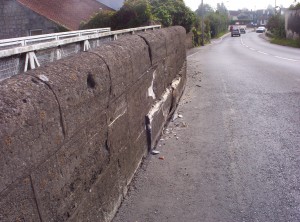Trevor Carbin
Wiltshire Councillor for Atworth, Holt and Staverton. Learn more
Government intervenes in lorry war
by trevorcarbin on 16 August, 2012
The threat of government action has given campaigners opposing Bath’s plan to divert HGV traffic through Wiltshire a hope of victory.
The battle between Bath and Wiltshire over Bath council’s plans to ban HGV traffic on Cleveland Bridge escalated when Wiltshire, along with Somerset and the Highways Agency, submitted an appeal to the Secretary of State for Transport. This appeal process is a relatively recent option, introduced as part of the Department for Transport’s new rules relating to road classification.
DfT have accepted that there are valid grounds for an appeal. They originally said they’d reach a decision in September, but according to the Bath Chronicle the decision will take about six months to be made, which would mean we’ll hear next February or March.
Bath intended to start the ban in June, and although there’s been no formal announcement the appeal has clearly stopped this from happening.
In their submission the objectors point out that DfT’s “Guidance on Road Classification and the Primary Route Network” (Jan 2012) requires that significant changes should be agreed between all of the authorities responsible for managing the primary route, to ensure consistency, and that unless the agreement of all affected authorities can be obtained, including the Highways Agency where appropriate, then changes to the primary route should not be made.
The guidance also reaffirms that under EU Directive 89/460/EC, the PRN must provide unrestricted access to 40 tonne vehicles. Bath say they’ve found a way round that legal requirement, but they won’t tell anyone how they’ve done that, claiming ‘legal privilege’.
The appellants conclude their letter to the DfT by saying: “DfT is formally requested to accept this appeal on behalf of the undersigned, and whilst it is fully understood that the views of both sides will need to be considered, our request is that the Secretary of State ultimately allows the appeal, and instructs Bath and North East Somerset Council to abandon their proposal to introduce a lorry ban on the A36 Primary Route.”
In their reply the DfT say:
“I am writing in response to your appeal in relation to the PRN status of the A36 in Bath. Specifically you argue that the introduction of traffic restrictions at the corner of Bathwick Street and Beckford Road, banning turning movements for vehicles over 18 tonnes, will have a serious impact on the ability of vehicles to travel using the primary route network (PRN)
Having examined the material in your letter, we agree that there is sufficient basis for an appeal. We will therefore begin the process of gathering information from affected councils. Once we have collected views from interested parties, we will decide whether the appeal should be upheld. The timetable for this will depend on the speed of response from local authorities, but we expect to reach a decision in August or September.
I understand, from your letter, that your primary concerns about the proposed restrictions are as follows:
- Traffic over 18T would be prevented from using the PRN as currently designated, impeding the functionality of the network.
- Freight traffic attempting to travel through Bath will be displaced onto other routes, and would face additional costs.
- You expect traffic to be diverted to routes outside of Bath, and particularly on the M4 and M32 around Bristol, with consequences for surrounding roads and communities.”
Your say: “As I understand it BANES Council has been in receipt of a considerable sum of Goverment money to alleviate their traffic problems. I fail to understand how they can retain that resource if their solution is to shovel the problem over the fence to adjacent councils. There is a solution in their own backyard. The Batheaston By-Pass was constructed. Yes it successfully reduced traffic through Batheaston. Howevever it does seem under utilised, especially the road leading down into the roundabout from the A46. My solution would be the construction of a relatively short section of road (less than .75 miles from a corner of the A36 just as it enters Bath, skirting Bathampton & connecting to the bypass. This would mean that heavy goods vehicles using the route along the A36 from Southampton to M4 motorway would not have to go into Bath crossing The Cleveland Bridge but go directly on to the A46. Additionally if a park and ride was constructed at the junction of the proposed road and the bypass this would further reduce congestion. If this is close to the river it is suggested river buses are used rather than road buses.”
1 Comment
The Ban must be allowed until a better solution is found. The most pressing of all the reasons is that Bathwick street, Bath is lined both sides by long five story terraced houses. This creates a high two-sided canyon that completely traps highly dangerous levels of Nitrous Oxide, caused overwhelmingly by HGV engines. Readings of these lethal gases by various bodies are well above E.U. levels of what is safe for humans. The one gap in these terraces is currently about to be filled in by private developers, which will lead to even more dangerous levels.
This is not about a small percentage increase to transport costs. This is about protecting the health of men, women and children.
This is a centuries old battle between the right of humans to a healthy life and not be poisoned in their own homes and the vested interests of industry, who cannot or will not look beyond the balance sheet . Shame on this government if the appeal is upheld. Shame indeed.